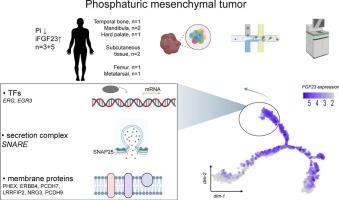对产生成纤维细胞生长因子23 (FGF23)的间充质肿瘤的单细胞和大量转录组分析揭示了其分泌表型的分子基础。
IF 3.6
2区 医学
Q2 ENDOCRINOLOGY & METABOLISM
引用次数: 0
摘要
肿瘤诱导骨软化症(TIO)是一种由分泌成纤维细胞生长因子23 (FGF23)的磷化间充质肿瘤(PMT)引起的罕见疾病。本研究的目的是分析pmt的转录组学特征。我们对10例患者(年龄44(41;64),血清磷酸盐(Pi)- 0.54 (0.43; 0.59) mM/L, FGF23-113 (40; 205) pg/ml)的肿瘤切除过程中获得的PMTs (n = 5)和周围骨组织(n = 4)进行了单细胞RNA (n = 3)和大量RNA测序。我们总共发现了22,449个细胞,分为13个不同的类别。我们确定了PMT细胞簇的异质性,随后将其分为两个肿瘤簇1和2,其特征是更深的上皮-间质表型转变,更高的FGF23表达以及各种SNP和CNV。我们进一步确定了肿瘤细胞分化驱动调控因子ERG和EGR3,基于等位基因表达评分和基于速度的伪时间,这可能在pmt的肿瘤发生中起关键作用。在单细胞和大量转录组分析中,我们发现囊泡特异性和胞吐相关基因(SLC30A3, SYT1, STX1A和SNAP25)上调,这很可能代表了所有PMT样品中活跃分泌的分子机制。我们报道了在肿瘤细胞群(PHEX, ERBB4, PCDH7, LRRFIP2)中表达的所有pts中的跨膜蛋白编码基因,这些基因被认为是潜在的诊断靶点。我们证实了FN1-FGFR1融合基因和Klotho在大多数pmt中的表达(8个中的6个)。结论:特异性SNARE蛋白基因的上调与PMT的转录特征为PMT的发病机制提供了新的认识,为进一步研究PMT的诊断和治疗干预提供了新的思路。本文章由计算机程序翻译,如有差异,请以英文原文为准。

Integrating single-cell and bulk transcriptome analysis of fibroblast growth factor 23 (FGF23)-producing mesenchymal tumors reveals molecular basis of its secretory phenotype
Tumor-induced osteomalacia (TIO) is a rare disorder caused by a phosphaturic mesenchymal tumor (PMT) secreting fibroblast growth factor 23 (FGF23).
The aim of this study was to analyze PMTs for their transcriptomic characteristics. We performed single-cell RNA (n = 3) alongside bulk RNA sequencing of PMTs (n = 5) and surrounding bone tissue (n = 4) obtained during tumor removal in 10 patients (age 44 (41;64), serum phosphate (Pi)- 0.54 (0.43; 0.59) mM/L, FGF23–113 (40; 205) pg/ml). We revealed a total of 22,449 cells divided into 13 different categories. We identified the heterogeneity of the PMT cell cluster and subsequently divided it into two tumor clusters 1 and 2 characterized by the deeper epithelial-mesenchymal phenotype transition, higher FGF23 expression as well as various SNP and CNV. We further identified tumor cell differentiation driving regulons ERG and EGR3, based on scoring by allele expression and velocity based pseudotime on a trajectory that may play a critical role in the tumorigenesis of PMTs. In both single-cell and bulk transcriptome analysis we found upregulation of vesicle-specific and exocytosis associated genes (SLC30A3, SYT1, STX1A and SNAP25) which most likely represent molecular mechanisms of active secretion in all PMT samples. We report transmembrane protein coding genes expressed in all PMTs specifically in tumor cell clusters (PHEX, ERBB4, PCDH7, LRRFIP2) which are suggested as potential diagnostic targets. We confirmed the presence of FN1-FGFR1 fusion genes and Klotho expression in most PMTs (6 out of 8).
Conclusion: specific SNARE proteins gene upregulation along with transcriptional signatures of PMT offer new insights into its pathogenesis which may be further studied for diagnostic and therapeutic interventions.
求助全文
通过发布文献求助,成功后即可免费获取论文全文。
去求助
来源期刊

Bone
医学-内分泌学与代谢
CiteScore
8.90
自引率
4.90%
发文量
264
审稿时长
30 days
期刊介绍:
BONE is an interdisciplinary forum for the rapid publication of original articles and reviews on basic, translational, and clinical aspects of bone and mineral metabolism. The Journal also encourages submissions related to interactions of bone with other organ systems, including cartilage, endocrine, muscle, fat, neural, vascular, gastrointestinal, hematopoietic, and immune systems. Particular attention is placed on the application of experimental studies to clinical practice.
 求助内容:
求助内容: 应助结果提醒方式:
应助结果提醒方式:


